Tamiya 1/48 KV-1
From September 2006:
History:
The KV-1 was a response to a 1939 specification for a heavy breakthrough tank armed with a 76.2mm cannon and armor capable of resisting anti-tank weapons up to the same caliber. The basis of the design was the SMK heavy tank prototype, which was equipped with two turrets, one with the 76.2mm low-velocity gun and the other a 45mm anti-tank gun.
After the failure of the multi-turret T-35, Stalin ordered there be no more multi-turret tanks, which resulted in a radical re-design in September 1939, creating a heavy tank with only one turret armed with the high velocity 76.2mm L30.5 gun and more armor protection, while maintaining a weight around 43 tons. The resulting KV-1 was named for Klimenti Voroshilov, the Soviet Commissar of Defense. In an attempt to decide which was the best design, the prototypes of the T-100, SMK and KV were sent to fight in Finland, manned by factory crews. Combat soon proved the ineffectiveness of the multi-turreted designs and demonstrated the superiority of the KV. Shortly afterwards, the order for serial production was signed and mass production began in the summer of 1940.
The KV-1 had armor 75mm thick and was powered by a 500 hp water-cooled diesel. With a crew of five, it weighed in at 44 tons. While the transmission caused problems, the wide-track treads allowed the KV-1 to traverse terrain that would have bogged down any other heavy tank.
The KV-1 was a nasty surprise for the German panzers in the summer of 1941. German 57mm and 75mm shells couldn't penetrate its heavy armor, while the 76.2mm cannon it carried had no trouble turning the Panzer III and Panzer IV into swiss cheese. German tank crews quickly named the KV-1 “the monster.” Even the 88mm anti-tank gun had trouble stopping a KV-1. The only way the Germans were able to achieve successes against it was to concentrate the fire of many tanks - in some cases an entire battalion - at ranges of 100 meters or less. Even this was not always effective and frequently only damaged the KV-1 without knocking it out. Maneuvering to the flanks and rear and opening fire at ranges of 50 meters or less still would not guarantee destruction.
The combat record of the KV-1 was outstanding. On August 19, 1941, a platoon of four KV-1s of the 1st Tank Division ambushed a German tank column near the Voiskovitsky collective farm outside Leningrad. The platoon leader, Senior Lieutenant Zinoviy Kolobanov, knocked out the two lead tanks. The others, unaware of what had happened, continued to advance. Kolobanov's platoon of four KV-1s advanced into the German formation and in the melee that followed, Kolobanov destroyed 22 German tanks, ramming at least one. His KV-1 was hit 135 times during the fight without effect. The other three KV-1s destroyed 16 other tanks. Kolobanov's feat made him the second highest ranking Soviet tank ace of the war.
During the Operation Taifun, the assault on Moscow, a KV-1 of the 89th Independent Tank Battalion commanded by Lt. Pavel Gudz knocked out ten German tanks while receiving 29 hits from enemy tanks and anti-tank guns, which failed to stop the KV-1.
In the tank battles at Brody-Dubno in Ukraine, the KV-1 played a vital role. Gen. Maj. Morgunov, the armor commander in Ukraine, reported: "Special mention should be made of the good work of the 4th, 8th and 15th Mechanized Corps who showed that a single KV tank was worth 10-14 enemy tanks in battle." Army commanders appreciated the KV-1's near invulnerability and pleaded for more. Gen. Maj. Rokossovsky said: "The KV tanks literally stunned the enemy. They withstood the fire of every type of gun that the German tanks were armed with."
Widely produced between 1940 and July 1941, the KV-1 served throughout the Second World War. Its design influenced both German and later Soviet armored vehicle development.
The Kit:
This is Tamiya's second major Soviet armored vehicle in this series of 1/48 kits. It represents a KV-1 Model 1940 LKZ early series production, carrying the F-32 76.2mm main gun in a welded turret, with the initial rubber lined resilient road wheels and curved rear hull profile. The kit is equivalent to the 1:35 Trumpeter KV-1 “Small Turret” Tank. The sprues include parts that are for the KV-1 Model 1941, which means Tamiya will likely release further kits in the KV series beyond the KV-2 that has already been announced.
This kit comes on the now-standard four sprues - one for the hull and associated equipment, one for the turret, and two for the road wheels and tracks - in dark green plastic, with a diecast lower hull. The molding is crisp, and the various items to fit on the hull are separate. The kit has 180 parts in olive drab plastic plus the cast metal lower hull tub, a decal sheet, a few poly caps, a length of twine for the tow cables and screws to hold the hull sections together. Decals are provided for three vehicles that fought at the Battle of Kharkov in May 1942.
Construction:
I call these little Tamiya armor kits “weekend models.” I don't mean that in a bad way. They are well designed and go together easily over the course of an evening. One can then spend the rest of the modeling time available over a weekend painting and weathering - of course, this is a “weekend” that doesn't include lots of “honey-do's” or “daddy-can-we's,” but even with those, it's not a long project. I now have a system for assembling these Tamiya tanks that really does make the whole process quite easy.
First I assemble the hull and turret separately, other than the items like tools and such that will go on later. Then I paint the model, including all the road wheels and suspension parts and tracks on the two A sprues. Then I apply the decals. Following that, I give a wash, and then weather the road wheels and track with mud or whatever. Then I return to assembly, construct the suspension and road wheels and attach them, then attach the tracks. I then attach the upper hull to the lower hull, then glue on the jacks, shovels, and whatever else goes on the hull, then I attach the turret. The system works perfectly with every one of these, and is very easy.
As far as specifics are concerned, there are no problems during assembly, since the typical Tamiya fit eliminates any hassles. The upper and lower hulls are screwed together with two self tapping screws with the fit between the front hull and the transmission cover being exact. The turret goes together without problems with excellent fit of parts.
As regards specifics
Both the road wheels and the idlers are to be glued in place on their axles. Suspension assembly is very straightforward. Remember to fit the drive sprockets in place before fitting the mud scrappers as the sprockets won't fit afterwards.
The tracks are in link and length, with the top run having track sag included between the return rollers. This makes aligning the tracks very easy. The shorter lengths are fitted around the idler and drive sprockets. The tracks have good cast details, though there are small pin marks on the inside of the links; these are hidden by the road wheels and sprockets and are not noticeable with the tracks assembled.
The upper hull is molded in one part that includes the fenders, with the engine deck separate with good bolt head details and separate rear hatches. The two small exhaust pipes are separate parts. The hull has no weld seams or surface texturing; those modelers who take the time to add weld seams with stretched sprue will improve the overall appearance. The fender supports are separate parts as is the hull nose cap. This part covers the lower/upper hull join line very nicely.
There is a separate driver's visor, a two part head light with solid plastic lens, a small siren and a three part machine gun and mounting plus the upper periscope cover. The driver's hatch is separate and has interior detail if you pose this open.
Three large storage boxes molded in one piece plus other small fittings and tow cables made with the twine provided finish the hull detail.
The turret shell is two halves with separate front, rear, and top panels. There are no seams to worry about since parts fit is excellent and subtle weld texturing is included. The fit of the gun mount is good but there is no cast texture on the gun mounting bulges. The top panel has a separate main hatch, as well as the four periscope covers, the two dome sights, and the side grab handles with the central front ventilator included. Fit of the roof to the turret is very good, and there is no need for trimming or filler.
I took the commander figure from the Tamiya Russian soldiers set, and modified it to fit this model. I used a different arm and cut off that hand, replacing it with one pointing. The figure is cut off at the waist since the lower part was designed to fit in the T-34 and does not fit here. For me, the figure in the turret gives a good idea of how big the KV-1 was - it's at least half again the size of the T-34 overall.
Color and Marking:
I painted the model overall with Xtracrylix RLM62 Green, which looks quite close to “Tractor Green,” which was the color used on Soviet Tanks. I then weathered the suspension, lower hull, the various road wheels, drivers and sprockets, and the tracks with Tamiya “Mud” from the weathering set.
I used the decals for the tank in the boxart, which was photographed for propaganda purposes with this slogan (which I don't know) just before the Battle of Kharkov.
Final Construction:
I assembled the suspension, then attached the tracks. I then screwed the upper and lower hull parts together. With this done, I “muddied up” the rest of the hull and turret. I then set the commander in the open hatch, attached the hatch, and set the turret in its place on the hull.
Conclusions:
This KV-1 is another winner in the increasingly-popular 1/48 scale armor released by Tamiya. It appears to be accurate according to various reviews at armor modeling sites, and is not a difficult kit.

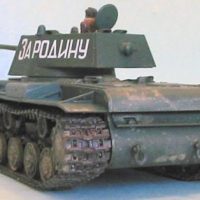
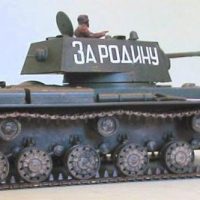
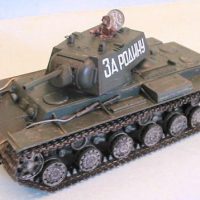
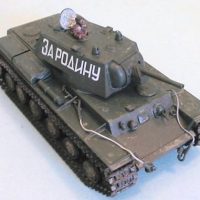
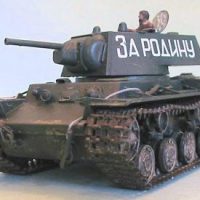
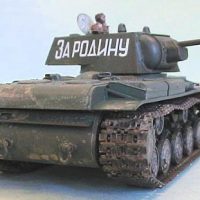
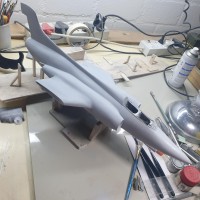
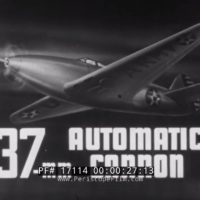
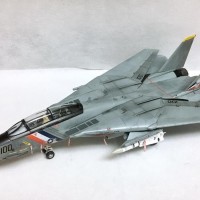
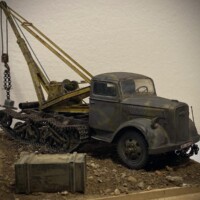
Great KV-1. The Germans would actually supply some of their tank crews with paper and wood models of the KV-1 to help with identification. The Tamiya 1/35 KV-1 includes a small paper cutout model of a KV-1 for the miniatures:
1 attached image. Click to enlarge.
Another great quarter scale Tamity armor, my friend @tcinla!
I liked the supporting text a lot!
The slogan should be : "FOR COUNTRY" (sort of): the Trumpeter 1/32 MiG-3 boxart sports the same slogan, that I am almost sure I've read somewhere it translates like this.
These Tamiya kits are perfect for beginners. I stashed a few bought 2nd hand then gave them away to kids wanting to start the hobby. Can t be dissapponted by a Tamiya, even though these molds are almost 40 years old. Always nice to see some armor here in imodeler! Thanks for sharing @tcinla
And the "beginners" don't necessarily have to be kids! 🙂
Fully agree, just saying - I enjoy a Tamiya from time to time, you really can build them in a weekend but also they leave room for kit bashing or aftermarket upgrades!
Great history lesson and model, Tom. The T-34 gets so much glory that the mighty KV-1 is often forgotten. I imagine the greatest weakness of the KV-1 was mobility, since it was relatively slow.
Interesting story. With exposed track like that it seems miraculous that one could take so many hits and survive. Then again, the soviets back then were not allowed to believe in Miracles. Providence maybe.